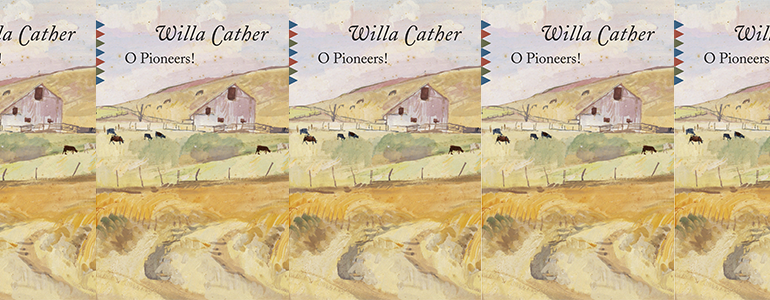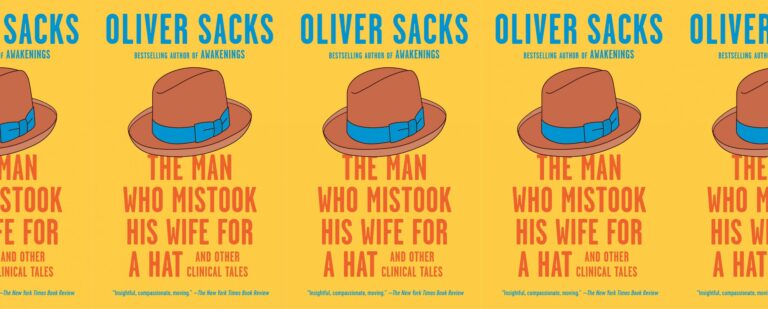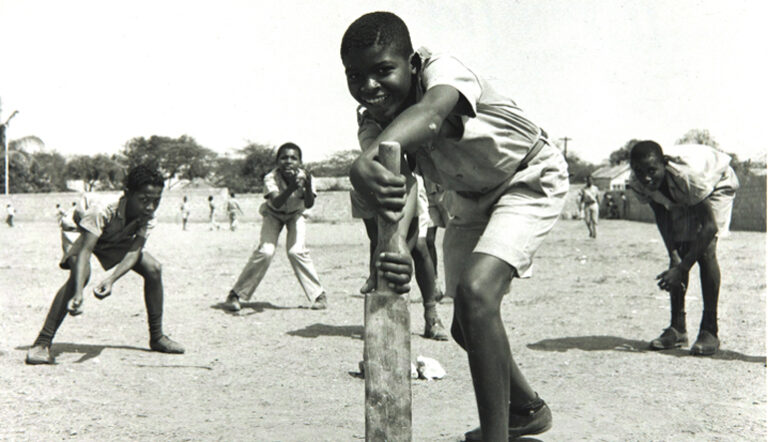Pioneer Days

Willa Cather took a leave from her position as managing editor of McClure’s to write her most famous novel, O Pioneers!, in 1913. She wrote it while living in New York City, NY, far from the prairie of Red Cloud, NE, where she grew up. Cather took the title of her novel from a poem by Walt Whitman, “Pioneers! O Pioneers!”, published in Leaves of Grass in 1900:
COME, my tan-faced children,
Follow well in order, get your weapons ready;
Have you your pistols? have you your sharp-edged axes?
Pioneers! O Pioneers!
On the heels of Whitman’s exaltation of the American spirit, complete with pistols and axes, O Pioneers! crafts an identity for the United States that stands in contrast to the rapid urbanization and industrialization that occurred when it was written. Cather’s America centers on the identity of the pioneer, a rough and romantic type more in harmony with nature than modern workers. But by 1913, the pioneer was already a part of the country’s mythologized past. A critic for the New York Times called the novel “American, in the best sense of the word,” but also admitted that this version of the US was unfamiliar to most readers. “The average American does not have any deep instinct for the land, or vital consciousness of the dignity and value of the life that may be lived up on it.” Nonetheless, the immediate success of O Pioneers! suggests that readers longed for the vision of the country that it offers. Still today, Cather’s novel provides a vision of America that is at once familiar and completely foreign. As the novel revels in scenes of natural beauty and “simpler” times, it also warns us that such idealized visions of America were dangerous and violent all along.
Cather’s heroine, Alexandra Bergson, is the daughter of Swedish immigrants who were drawn to the Nebraska prairie by the Homestead Act of 1862. After struggling for years with debt, cholera, and blizzards, Alexandra’s father dies at the beginning of the novel; the family faces destitution if the fortunes of the farm don’t change soon. We meet Alexandra again sixteen years later, when she has turned the family farm into one of the richest and most prosperous in the area. Cather describes Alexandra’s prominent house as “curiously unfinished and uneven in comfort.” Alexandra is not a domesticated housewife. She remains unmarried, and her assertive decision-making threatens and alienates her two brothers, Lou and Oscar, who live nearby.
Alexandra seems at once the character who belongs most to the land and the one who is consistenly out of place. She takes seriously her role as the land’s caretaker. “We come and go, but the land is always here,” Alexandra tells her companion, Carl, at the novel’s end. “And the people who love it and understand it are the people who own it—for a little while.” Alexandra’s respect for the land is what sets her apart from the men around her and her fellow pioneers. Her brothers assume that the land owes them something simply by its being there, but Alexandra learns otherwise. When her brothers want to sell the family farm and find jobs in a factory, Alexandra refuses. “Sometimes I feel like I’m getting tired of standing up for this country,” she admits. Her submission to the land and her understanding of its continuity provides her with a perspective that ultimately ensures the farm’s prosperity.
But O Pioneers! isn’t a novel about Alexandra’s success, and it ultimately ends in tragedy. Alexandra’s beloved brother Emil is in love with Marie Shabata, a neighbor and Alexandra’s closest friend. Marie is unhappily married to Frank, a character who embodies the violent anger of a man who feels the world has not given him what he deserved. “He did not believe that he had any real grievance,” Cather writes, “but it gratified him to feel like a desperate man.” Emil and Marie lay together under a mulberry tree on Marie’s farm, but Frank, Marie’s husband, eventually returns home drunk. He grows suspicious when he finds Emil’s horse in his stable, heads into his fields with his .405 Winchester, and shoots the lovers under the dark shadow of night. “For Emil the chapter had been short. He was shot in the heart, and had rolled over on his back and died.” Cather describes in cruel detail. “But for Marie Shabata it had not been so easy. One ball had torn through her right lung, another had shattered the carotid artery. She must have started up and gone toward the hedge, leaving a trail of blood. There she had fallen and bled. From that spot there was another trail, heavier than the first, where she must have dragged herself back to Emil’s body.”
The aftermath of this murder is a jarring contrast with the pristine and spacious beauty of the prairie that occupies the rest of the novel. The scene belongs to Cather’s vision of America, nonetheless. Shocking as Emil’s and Marie’s violent deaths might be, their end is less a surprise than an inevitable rupture that always haunts this vision of American life. As if to convince us that this violence is part of the land, Alexandra finds a way to forgive Frank for killing her brother and her best friend. She visits him in jail and promises that she will try to get him a pardon. After all, she and Frank were “wrecked by the same storm,” a promise of American privilege and prosperity at all costs that could never be fulfilled.
O Pioneers! takes place in the fictional town of Hanover, NE. I live in Ohio, which is not Nebraska, but the two are lumped together as part of middle America, referred to as the fly-over states by those who live closer to a coast. The America of O Pioneers! feels close to me, as if I live in its legacy. But that is not to say that the Midwest hasn’t changed since the early twentieth century or that I have any “deep instinct for the land,” even though I have lived in the Midwest for most of my life. Rather, I sense Frank’s sense of entitlement and conjured grievances, as if some sort of mythologized path is slipping away.
The Midwest of the twenty-first century still clings to the myth of the pioneer as much as those in the moment of Whitman and Cather did. One day last spring, my daughter came home from school with a note about Pioneer Day. Most people who grew up in the middle of the United States in the last thirty years remember such celebrations, when elementary school kids trade in their computers for handheld chalkboards, listen to math lessons while sitting on hay bales, and learn how to churn butter. My daughter’s school sits in the middle of a field three times its size. Tucked into the ground so that we walk down a flight of stairs to get to its front door, its design reminds me of the sod houses Cather describes on the Nebraska plains, depressed into the earth and protected from harm. On an eighty-five-degree day in mid-May, my daughter dressed in clothes that were hardly compatible with global warming: a thick muslin dress, bonnet, and apron that we borrowed from a neighbor’s daughter who underwent this same ritual several years before. The local historical society set up activities in the grassy fields surrounding the school. Stations for spinning, blacksmithing, and sack races formed. Aisles of hay bales were arranged under a large oak tree to provide a makeshift classroom.
While my daughter participated in the day’s pioneer activities, I couldn’t help but think about the gaps and contradictions in the recreation of the past that seem to be present but not addressed. My daughter’s teacher encouraged students to make rag dolls and provided fabric to represent a range of skin tones. But neither my daughter, who has Down syndrome, nor her non-white friends would be part of this classroom in olden times. They are now given the opportunity to participate in its reenactment, but it is not their history that they rehearse.
“Of all the bewildering things about a new country,” Cather writes, “the absence of human landmarks is one of the most depressing and disheartening.” A landscape untouched by humans is hard to imagine now. In the small town where I live, deer and people dodge each other in traffic. The endless fields of corn that surround my town are shockingly flat. One mile from my house, they seem to spread in every direction, barns and farmhouses occasionally breaking up the countless repetition of green stalks. On walks I often stop and look at them, searching the flat horizon in the same way one might look at the ocean. But their nostalgic connection to “simpler” times is hard for me to conjure. I can’t look at these fields of corn and not remember the massive board with “Hillary for Prison” painted on it that stood by the side of the road in front of one of these farms for most of 2016. This threat of violence was already present in Lou’s and Oscar’s resentment of Alexandra as the family’s leader.
Living in a rural town has benefits that draw on the lingering idealism of the prairie. My home is surrounded by lush and ever-changing nature. In summer, we can buy most of the food we eat from local farms. On warm evenings, my daughter and I drive ten minutes through corn fields to a you-pick flower stand. We clip a jar full of sunflowers and dahlias and pay on the honor system, leaving money in an aluminum bucket. But these benefits that affirm the community of the prairie have a dark side, just as Cather warned us of in her novel. On a drive through the cornfields, we see dilapidated houses with small plastic slides and other toys scattered on the grass in the front yard, Confederate flags hanging from the porch. We glance at the shooting range that is located a half mile away from the town’s middle school. We see large farmhouses that sit on multi-acre lots with signs that announce their righteousness: “Don’t Blame Me I Voted for Trump.” O Pioneers! reminds me that the promise of American prosperity was always an illusion, and it was likely to slip away from those who saw themselves as entitled to it.


